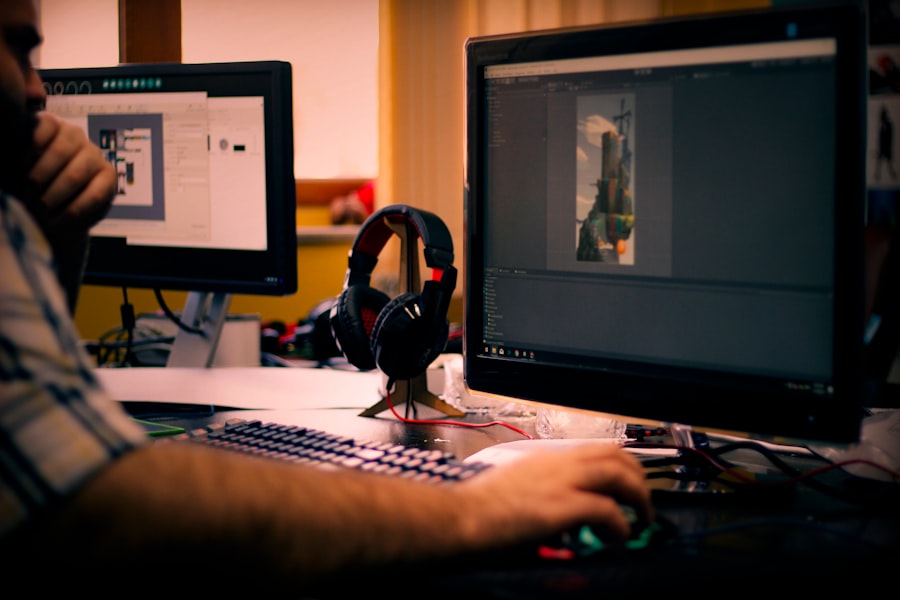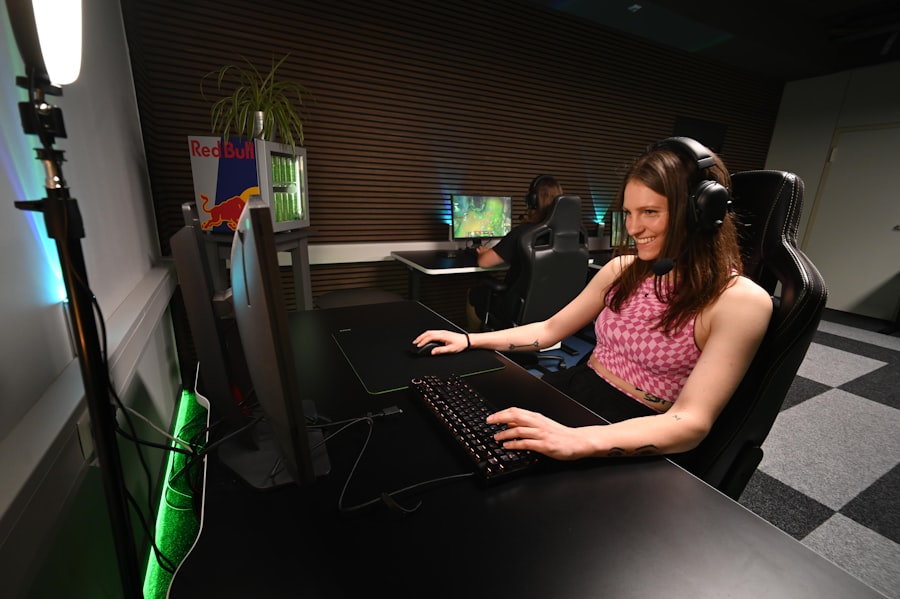As you delve into the world of video games, you may have noticed a significant transformation in how these digital experiences are created and delivered. Artificial Intelligence (AI) has emerged as a powerful tool, reshaping various aspects of the video game industry. From enhancing gameplay mechanics to streamlining development processes, AI is becoming an integral part of how games are designed and produced.
This technological advancement not only improves the gaming experience for players but also influences the roles of those who create these virtual worlds, including illustrators and artists. The integration of AI into video game development is not merely a trend; it represents a paradigm shift that is redefining the industry. As you explore this evolution, you will find that AI is not just about automating tasks but also about augmenting human creativity.
This article will take you through the multifaceted impact of AI on video game illustration jobs, particularly in China, where the gaming market is booming and innovation is at the forefront. By understanding these dynamics, you can better appreciate the future landscape of video game illustration and the opportunities and challenges that lie ahead.
Key Takeaways
- AI is revolutionizing the video game industry, impacting various aspects including illustration jobs and development.
- AI is changing the role of video game illustrators by automating certain tasks and enhancing creativity.
- China is experiencing a rise in AI integration in video game development, impacting the job landscape for illustrators.
- Video game companies in China are embracing AI technology to improve efficiency and creativity in game illustration.
- While AI offers advantages such as efficiency and innovation, it also raises ethical considerations and challenges for the future of video game illustration jobs in China.
The Impact of AI on Video Game Illustration Jobs
As you consider the role of AI in video game illustration, it becomes clear that its influence is profound. Traditionally, illustrators have relied on their artistic skills to create characters, environments, and assets that bring games to life. However, with the advent of AI tools, the landscape is changing.
AI can now assist in generating artwork, automating repetitive tasks, and even suggesting design elements based on player preferences or market trends. This shift allows illustrators to focus more on the creative aspects of their work while leaving mundane tasks to machines. Yet, this transformation raises questions about job security and the future of illustration roles.
As AI becomes more capable of producing high-quality visuals, you might wonder whether human illustrators will become obsolete. While some fear that AI could replace jobs, it is essential to recognize that technology often creates new opportunities as well. The collaboration between human creativity and AI capabilities can lead to innovative designs and unique artistic expressions that neither could achieve alone.
Thus, rather than viewing AI as a threat, it can be seen as a tool that enhances your creative potential.
The Rise of AI in Video Game Development in China

In recent years, China has emerged as a powerhouse in the global video game industry, with a rapidly growing market that embraces technological advancements. As you explore this landscape, you’ll find that AI is playing a pivotal role in shaping the future of game development in the country. Chinese companies are increasingly adopting AI technologies to streamline their production processes, enhance player experiences, and create more immersive worlds.
This trend is not only transforming how games are made but also influencing the skills required for professionals in the field. The rise of AI in China’s video game development sector is evident in various applications, from procedural content generation to advanced player analytics. You may notice that many games now utilize AI algorithms to create dynamic environments that adapt to player behavior or preferences.
This level of personalization enhances engagement and keeps players coming back for more. As a result, the demand for skilled professionals who can work alongside AI technologies is on the rise, creating new opportunities for illustrators and artists who are willing to adapt and learn.
How AI is Changing the Role of Video Game Illustrators
| Metrics | Impact |
|---|---|
| Efficiency | AI tools help illustrators create assets faster |
| Quality | AI can enhance the details and realism of game graphics |
| Cost | AI reduces the cost of creating game art assets |
| Creativity | AI can inspire new ideas and styles for illustrators |
As you navigate the evolving landscape of video game illustration, it’s crucial to understand how AI is reshaping your role as an illustrator. With AI tools capable of generating assets and automating certain tasks, your responsibilities are shifting from purely creating visuals to curating and refining them. You may find yourself spending more time on conceptualization and less on repetitive tasks like coloring or shading, allowing for greater exploration of artistic ideas.
Moreover, AI can serve as a collaborative partner in your creative process. Imagine using AI algorithms to generate multiple design variations based on your initial sketches or concepts. This capability not only speeds up the design process but also opens up new avenues for creativity.
You can experiment with different styles and elements without being bogged down by technical limitations. As a result, your role as an illustrator becomes more dynamic and multifaceted, requiring you to embrace technology while honing your artistic vision.
Advantages and Disadvantages of AI in Video Game Illustration
As you weigh the pros and cons of integrating AI into video game illustration, it’s essential to consider both sides of the equation. On one hand, AI offers numerous advantages that can enhance your workflow and creative output.
This efficiency allows you to focus on higher-level creative decisions and produce more content in less time. However, there are also disadvantages to consider. The reliance on AI-generated content may lead to a homogenization of artistic styles, as many illustrators might use similar tools and algorithms.
This could result in a lack of diversity in visual aesthetics across games, making it challenging for unique voices to stand out. Additionally, there are concerns about job displacement as AI continues to advance. While it may create new opportunities for collaboration, it also raises questions about the future demand for traditional illustration skills.
The Future of Video Game Illustration Jobs in China

Looking ahead, the future of video game illustration jobs in China appears both promising and uncertain. As the gaming industry continues to grow at an unprecedented rate, there will be an increasing demand for skilled illustrators who can navigate the complexities of working alongside AI technologies. You may find that your ability to adapt and learn new tools will be crucial in securing your place within this evolving landscape.
Moreover, as Chinese companies continue to push boundaries in game development, there will be opportunities for illustrators to contribute to innovative projects that leverage AI in exciting ways. The fusion of human creativity with advanced technology could lead to groundbreaking visual experiences that captivate players worldwide. However, staying relevant will require continuous education and a willingness to embrace change as the industry evolves.
How Video Game Companies in China are Embracing AI Technology
Chinese video game companies are at the forefront of embracing AI technology to enhance their development processes and improve player experiences. As you observe this trend, you’ll notice that many companies are investing heavily in research and development to integrate AI into their workflows. From automating quality assurance testing to utilizing machine learning algorithms for player behavior analysis, these companies are leveraging technology to gain a competitive edge.
Furthermore, collaboration between artists and AI developers is becoming increasingly common within these companies. You may find that interdisciplinary teams are formed to explore how AI can enhance artistic expression while maintaining a human touch. This collaborative approach not only fosters innovation but also ensures that the unique perspectives of illustrators are integrated into the development process.
As a result, you can expect to see more diverse and engaging games emerging from China’s vibrant gaming industry.
The Role of Human Creativity in Video Game Illustration
Despite the advancements in AI technology, human creativity remains an irreplaceable element in video game illustration. As you reflect on your role as an illustrator, it’s essential to recognize that while AI can assist with technical tasks, it cannot replicate the depth of human emotion and imagination that informs artistic expression. Your ability to convey stories through visuals, evoke emotions through color palettes, and create unique characters is something that machines cannot fully replicate.
Moreover, the collaboration between human creativity and AI capabilities can lead to groundbreaking innovations in design. By leveraging AI tools while infusing your personal style and vision into your work, you can create truly unique experiences for players. The future of video game illustration lies not in choosing between human artistry and machine efficiency but rather in finding a harmonious balance between the two.
Education and Training for Video Game Illustrators in the Age of AI
As you consider your career path as a video game illustrator in this age of AI, it’s crucial to invest in education and training that prepares you for the evolving landscape. Traditional art skills remain essential; however, familiarity with AI tools and technologies will set you apart from your peers. You may want to explore courses or workshops that focus on digital art techniques while also incorporating training on how to use AI software effectively.
Additionally, staying updated on industry trends and emerging technologies will be vital for your professional growth. Engaging with online communities or attending conferences can provide valuable insights into how other illustrators are integrating AI into their workflows. By continuously expanding your skill set and knowledge base, you’ll position yourself as a versatile artist capable of thriving in an ever-changing environment.
Ethical Considerations of AI Taking Over Video Game Illustration Jobs
As you navigate the implications of AI’s rise in video game illustration, ethical considerations come into play. One significant concern revolves around job displacement; as machines become more capable of producing artwork autonomously, there is a fear that human illustrators may face reduced job opportunities. It’s essential to engage in discussions about how society can balance technological advancement with preserving meaningful employment for artists.
Another ethical consideration involves issues related to copyright and ownership of AI-generated content. As an illustrator working alongside AI tools, questions may arise regarding who owns the rights to artwork created with machine assistance. These discussions will shape policies within the industry moving forward and require input from artists like yourself who are directly impacted by these changes.
Navigating the Changing Landscape of Video Game Illustration in China
In conclusion, as you navigate the changing landscape of video game illustration in China, it’s clear that AI is both a challenge and an opportunity for artists like yourself. Embracing technology while maintaining your unique creative voice will be crucial for success in this evolving industry. By understanding how AI impacts your role and staying informed about emerging trends, you can position yourself at the forefront of innovation.
The future holds exciting possibilities for collaboration between human creativity and artificial intelligence within video game illustration. As you continue your journey as an illustrator, remember that your artistic vision is invaluable—AI may enhance your capabilities but cannot replace the essence of what makes art truly meaningful. By adapting to these changes while nurturing your creativity, you can thrive in this dynamic environment and contribute to shaping the future of video games in China and beyond.
In recent years, the rapid advancement of artificial intelligence has begun to reshape various industries, including the realm of video game illustration. In China, AI is increasingly being utilized to create artwork for video games, leading to concerns about job displacement among human illustrators. This trend is part of a broader movement where AI is transforming creative fields by offering faster and often cheaper alternatives to human labor. For more insights into how technology is influencing job markets and economic growth, you can explore related discussions on How Wealth Grows. This platform delves into the intersection of technology and economic development, providing a comprehensive look at how innovations like AI are reshaping industries worldwide.
FAQs
What is AI?
AI, or artificial intelligence, refers to the simulation of human intelligence in machines that are programmed to think and act like humans. This includes tasks such as learning, problem-solving, and decision-making.
How is AI impacting video game illustrators in China?
AI is impacting video game illustrators in China by automating the process of creating game art. AI technology can generate high-quality game art, such as character designs and backgrounds, at a faster pace and lower cost than human illustrators.
What are the implications of AI taking video game illustrators’ jobs in China?
The implications of AI taking video game illustrators’ jobs in China include potential job displacement for human illustrators, as well as a shift in the skill sets and roles required in the video game industry. Additionally, there may be concerns about the quality and originality of AI-generated game art.
How are video game illustrators in China adapting to the rise of AI?
Video game illustrators in China are adapting to the rise of AI by developing new skills and expertise that complement AI technology, such as concept art creation, storytelling, and art direction. Some illustrators are also exploring opportunities to collaborate with AI systems to enhance their creative process.
What are the future prospects for video game illustrators in China in the age of AI?
In the age of AI, video game illustrators in China may need to continuously evolve their skills and adapt to new technologies in order to remain competitive in the industry. There may also be opportunities for human illustrators to leverage AI as a tool to enhance their creative output and explore new artistic possibilities.
